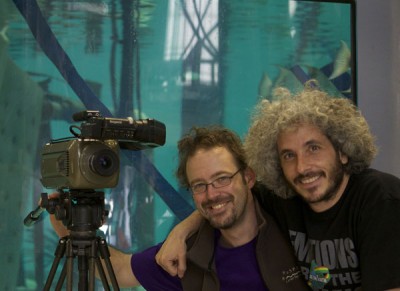Featured Stories | December 9, 2013
Lights, Camera, Action: Revealing the Ocean’s Invisible Beauty
By Genevieve Wanucha
When he’s not using the physics of black holes to study turbulence in superfluids, MIT theoretical physicist Allan Adams collaborates with underwater photographer Keith Ellenbogen to make the subtle, rapid movements of sea creatures visible to the human eye. In their most recent work, they used a Phantom V12 high-speed camera and lighting to film a variety of New England Aquarium (NEAq) finned denizens, including sharks, lionfish, monkfish and cuttlefish, at 1,200 frames per second in high definition. The videos, when played back in extreme slow motion, expose an awe-inspiring world.
“When you see, in real time, a black nose shark turning on a dime, it looks, well, fast,” Adams says. “But slowed down by an order of magnitude or two, you get to see the intricate orchestration of muscle, control surfaces, spine, and the subtle balletic choreography on many different length and time scales. It’s just breathtaking.”
This artful application of videographic technology reveals the complexity and dynamism of underwater locomotion. For example, the cuttlefish video demonstrates the fluid dynamics of the mollusk’s hunting practice: the cuttlefish’s undulating fins allow it to hover completely still in turbulent waters. While stopped, he releases two front tentacles, which serve as a platform from which to launch his attack. Four pairs of arms fan out, encircle the prey, and pull it into an open beak. As a result of this filming experience, the cuttlefish is now Adams’ favorite marine creature.
At its core, “The Invisible Oceans-Extreme Time” is an MIT project. It started in 2011 when Adams contacted Jim Bales, the Assistant Director of the MIT Edgerton Center for High-Speed Imaging for help photographing the high-speed collision of a cookie and a potato pancake for MIT’s Great Latke vs. Hamentashen Debate (a humorous academic event held to determine the superior of two traditional Jewish foods). A fascination with the revealing power of high-speed filming stuck.
The plans to bring out the hidden beauty of sea creatures materialized in a dinner conversation with Adams’ friend Keith Ellenbogen, an accomplished underwater photographer/videographer. It wasn’t hard to convince the NEAq to allow them access to their exhibits, as the aquarium’s team is a long-time fan of Ellenbogen’s work. “When someone says they want to bring an extraordinary camera to the aquarium and capture the most mind blowing images of sea life you can possibly imagine,” says Jeff Ives, Editorial Director of the NEAq, “you don’t just say yes, you say what can I do?”
There’s nothing easy about filming underwater in an aquarium tank. The tank walls limit the photographer’s freedom to move with the animal inside the tank, and the glass windows make shooting from the outside an optical challenge because they produce reflections. And by the project’s nature, Adams and Ellenbogen literally can’t see the details they want to capture. “The challenge in capturing these rare moments is knowing how to set yourself up to capture them,” says Ellenbogen. “To capture the fast, you need the technology, but to see rare behaviors, you need to know what to look for and how to orchestrate the setting.” To get the shots they wanted, Adams and Ellenbogen enlisted the help of technical master Jason O’Connell at Tech Imaging Services, Inc., who provided both the camera and considerable expertise, and the NEAq aquarists who shared their intimate knowledge of the animals’ behaviors.
The final shots were featured in a spectacular television campaign, the first TV ads for the NEAq in over thirty years, which ran on cable stations throughout New England this summer. Adams and Ellenbogen revealed a compilation of their best shots to a full house in a free public lecture at the aquarium last August, which they plan to show again at a later date. For now, you can see some of the clips right here on Oceans at MIT.
![]() More Underwater Film Clips from The Invisible Oceans-Extreme Time
More Underwater Film Clips from The Invisible Oceans-Extreme Time





